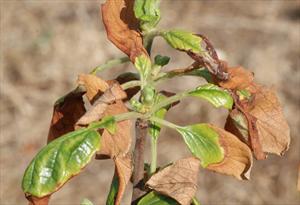 Frost damage on new apple leaves
Frost damage on new apple leavesOvernight spring frosts are a serious problem for fruit tree owners. Newly-emerging leaves and blossom can be damaged by freezing temperatures, causing a check to growth and a reduction in fruit production for that year. Most varieties will readily re-grow new leaves that have been damaged by frost, and some varieties will manage a limited second flush of blossom - but a severe overnight frost in spring is likely to cause serious damage.
The photo shows severe frost damage to newly-emerged leaves on an apple tree. These leaves will eventually drop away, and the swelling of replacement leaves can already be seen in the centre of the picture.
How to minimise the chances of frost damage
There is a common mis-conception that late-blooming varieties are less-likely to be affected by frost. It is true that as spring progresses the likelihood of overnight frost reduces, but it only takes one night of frost to do the damage. Conversely, early-blooming varieties, which have already set fruit, are unlikely to be affected by a late frost.
- Plant several different varieties, with different blooming times. This is perhaps the best method of ensuring you will get a crop each year, as it is unlikely that all of them will be affected by frost damage.
- Avoid planting your fruit trees in frost-pockets. Cold air is a bit like water, it flows downhill and pools at the bottom of slopes. Therefore plant your fruit trees at the top or half-way down the slope, allowing the cold air to drain past them. Similarly windy exposed situations are not often prone to frost damage (although of course these pose other challenges for fruit trees).
- Be cautious of east-facing positions. The damage caused by frost is sometimes less if the freezing and thawing occurs slowly. This is less likely in an area which gets strong morning sunshine because the tree will heat up quickly.
- Choose fruit tree varieties with frost-resistant blossom. If you know you are in a frost-prone area, these varieties are able to resist the damaging effects of freezing and thawing. However no variety is frost-proof, so plant several varieties if possible.
- Put a protective fleece over the tree. A horticultural fleece provides excellent protection for tender blossom and leaves. For dwarf trees you may be able to cover the whole tree, and even for larger trees you should still be able to cover a branch or two. However this method only works if you check the weather forecast in advance and remember to cover the tree - and don't forget to remove the covering the next day to allow bees to access the blossom.
